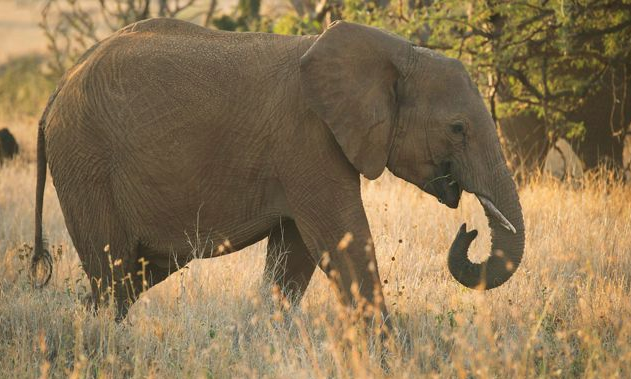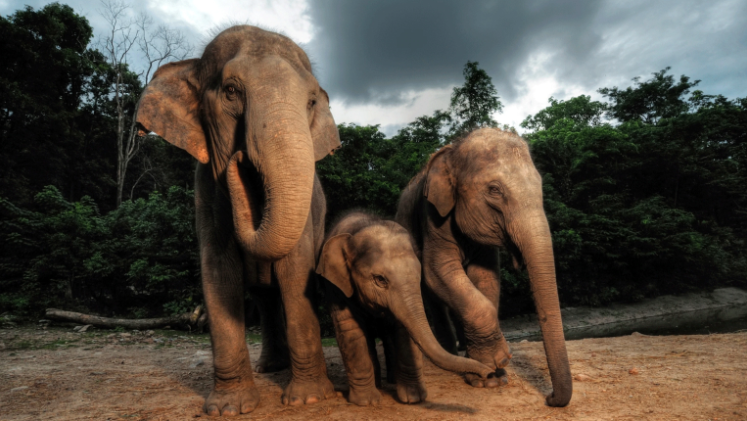Endangered Elephants – The future looks grim for the three existing elephant species. The African bush elephant and the Asian elephant find themselves on the brink of extinction as they are classified as endangered, while the African forest elephant is in an even more perilous situation, labeled as critically endangered. Unfortunately, the populations of these endangered elephants in Africa and Asia are dwindling rapidly and becoming increasingly scattered and isolated.
Here, we delve into the plight of these three endangered elephants and explore the imminent dangers they confront.
Introduction To Elephants

Elephants, despite being widely known and easily recognizable creatures, are facing a grave danger. These magnificent beings, renowned for their unique appearance, remarkable intelligence, and legendary long-term memory, confront an uncertain destiny. Over the past decade, the population of wild elephants has declined by a staggering 62%, posing an ever-increasing risk of extinction.
There are three existing species of elephants: the African bush elephant, the African forest elephant, and the Asian elephant. These species collectively belong to the Elephantidae family, which also includes several extinct members such as the mammoths. It’s worth noting that mastodons, while related, belong to a different family known as Mammutidae.
All three living elephant species are currently listed as threatened on the IUCN Red List, a comprehensive index of endangered species compiled by the International Union for Conservation of Nature (IUCN).
The primary challenges faced by elephants stem from two main sources: poaching and the loss of their natural habitats.
Elephant Poaching
Poachers target elephants primarily for their valuable ivory tusks, which are highly sought after and traded by criminal networks on the underground market. Ivory, a hard and white material, is obtained from the tusks and teeth of various animals, notably elephants. The term “ivory” originates from an ancient Egyptian word referring to elephants.
For over 3,500 years, humans have engaged in the trade of ivory. This trade held significant importance in Africa’s history, to the extent that a country in Western Africa, known as Ivory Coast or Côte d’Ivoire, was named after this material. Ivory possesses qualities such as durability, ease of craftsmanship, and aesthetic appeal, making it desirable for the production of diverse items like knife handles, billiard balls, piano keys, pipes, and ornamental objects.
Unfortunately, the ivory trade has caused a significant decline in the populations of all three elephant species. During the 1980s, half of Africa’s 1.3 million elephants were killed to meet the demands of the ivory trade. In response to this crisis, in 1989, a worldwide ban on the trade of African elephant ivory was imposed by CITES, the Convention on International Trade in Endangered Species of Wild Fauna and Flora. Despite subsequent rulings prohibiting the sale of ivory, the illegal ivory trade persists, leading to continued hunting of elephants for their tusks.
Habitat Loss
In Africa, poaching poses the greatest danger to elephants, although habitat loss is also a significant concern. However, the situation is different in Asia.
Both Africa and Asia have experienced significant population growth among humans in recent times. As a consequence, extensive savannas and forests, which have long served as the natural habitats of elephants, have been destroyed to accommodate the expanding cities, towns, farms, plantations, roads, and other human activities.
This relentless destruction of their habitats has forced elephants into smaller areas that are inadequate to sustain large elephant populations. Furthermore, the elephant communities have become increasingly fragmented, putting them at higher risk of diseases and genetic issues.
Human-Elephant Conflict
Loss of natural habitats heightens the probability of clashes between humans and elephants. Despite being herbivores, elephants possess significant size and strength, necessitating ample room to thrive.
Elephants not only pose a threat to crops but also pose a danger to humans, resulting in the loss of hundreds of lives annually. Consequently, local communities perceive elephants as a peril to their means of survival and personal safety. This predicament adds to the numerous obstacles confronted by conservationists.
Africa’s Elephants
Africa is the dwelling place of two remarkable elephant species: the African bush elephant and the African forest elephant. These magnificent creatures belong to the Loxodonta genus, and for some time, they were thought to be variations of a singular African elephant species.
Spanning across vast regions of sub-Saharan Africa, African elephants grace the landscape with their presence.
African Bush Elephant / African Savanna Elephant

Known scientifically as Loxodonta africana, the African bush elephant holds the status of being endangered. It is renowned as the largest and heaviest land-dwelling creature on Earth.
Male African bush elephants reach heights ranging from 3.04 to 3.36 meters (9.97 to 11.02 feet), while females measure between 2.47 to 2.73 meters (8.1 to 8.96 feet) in height. In terms of weight, males weigh approximately 5.2 to 6.9 metric tons (5.73 to 7.6 short tons), whereas females range from 2.6 to 3.5 metric tons (2.87 to 3.86 short tons).
To put the weight into perspective, a male African bush elephant weighs more than four times the weight of an average hatchback car. Females are about half the weight of males.
The largest-known African bush elephant weighed over 10 metric tons (11.02 short tons).
These majestic creatures are adaptable to various habitats, including forests, woodlands, and deserts. However, they are primarily found in savannas and open plains. Females live in herds alongside their offspring, while males, once mature, become more independent and live solitary lives or form small bachelor groups.
One distinguishing feature of the African bush elephant is that both males and females have tusks, whereas in Asian elephants, it is primarily the males who possess tusks.
The population of African elephants, including both bush and forest species, currently stands at around 415,000 individuals, which is only half of what it was in the 1930s. Despite numerous conservation efforts, the species continues to experience a decline in population.
Even today, the primary threat to the African bush elephant is poaching, driven by the demand for ivory in the illegal trade.
Loss of habitat is another significant factor contributing to the ongoing decline of these elephants. As Africa’s human population continues to rise, the expansion of agricultural activities, urbanization, and infrastructure development result in the destruction of the elephant’s traditional habitat.
African Forest Elephant

Scientifically known as Loxodonta cyclotis, the African forest elephant is in critical danger of extinction. Standing at heights of 2.09 to 2.31 meters (6.86 to 7.58 feet) for males and 1.8 to 2.4 meters (5.91 to 7.87 feet) for females, these elephants are relatively smaller compared to their counterparts. Male forest elephants weigh between 1.7 to 2.3 tons (1.87 to 2.53 short tons), while females weigh between 1.5 to 1.9 tons (1.65 to 2.09 short tons).
As the name implies, African forest elephants inhabit forested areas, specifically tropical forests and other forest habitats in western and central Africa. The largest surviving populations of these elephants can be found in Gabon and the Republic of the Congo.
Fruits constitute a significant portion of the African forest elephant’s diet, alongside bark and leaves from trees. Their consumption of fruits plays a crucial role in the ecosystem of African forests by aiding in seed dispersal. In fact, the dung of these elephants contains seeds from over 70 tree species.
Illegal poaching poses the greatest threat to these endangered elephants. Additionally, deforestation poses a significant risk to the species, leading to the fragmentation of their population as their forest habitat continues to diminish.
Asian Elephant

Scientifically known as Elephas maximus, the Asian elephant is currently listed as an endangered species. Standing tall at heights ranging from 2.28 to 2.89 meters (7.48 to 9.48 feet) for males and 2.28 to 2.52 meters (7.48 to 8.27 feet) for females, it is the second-largest land animal globally and the largest in Asia.
Compared to African elephants, Asian elephants exhibit distinct characteristics such as smaller ears, a generally convex back instead of a concave one, and smoother skin. One notable difference is that female Asian elephants rarely possess tusks, making males more vulnerable to poaching.
The Asian elephant’s size and valuable attributes make it a target for illegal activities. Poachers exploit these magnificent creatures for their ivory tusks and sought-after skin, which is used in various products, including jewelry beads. The black market trade involving elephants and ivory is particularly rampant in Thailand.
Tragically, Asian elephant calves are often stolen and smuggled from their native lands to Thailand. There, they are subjected to harsh training methods and exploited for the tourist industry. This brutal practice further contributes to the plight of these elephants.
While poaching remains a significant issue, the Asian elephant faces its greatest threat from habitat loss and fragmentation. Deforestation due to logging, the expansion of agricultural plantations, urban growth, and the development of infrastructure like roads, railways, and power lines all contribute to the destruction of the elephant’s natural habitat.
The increasing human population in Asia exacerbates the conflict between humans and elephants. This conflict arises from elephants damaging valuable crops, resulting in significant economic losses each year. Moreover, the presence of these large and dangerous animals leads to the loss of hundreds of human lives annually. It is a tragic consequence of the dwindling space shared between humans and elephants.
Currently, the total Asian elephant population consists of approximately 40,000 to 50,000 individuals, with about 60% residing in India. Astonishingly, this number is smaller than the capacity of many sports stadiums. Over the past three generations, the Asian elephant population has declined by at least 50%.
These facts highlight the urgent need for conservation efforts to protect the Asian elephant from further decline and ensure its survival in the wild.
Elephant Extinction
The unique and alarming reality is that elephant populations are declining and becoming increasingly fragmented, making the threat of extinction all too real for these remarkable creatures.
Elephants take a considerable amount of time to see a significant increase in their populations. Female elephants typically begin breeding when they reach the age of at least nine years, while male elephants start breeding in their teenage years.
The gestation period for elephants is one of the longest among all mammals, lasting approximately two years. Additionally, there are several years between each birth, resulting in a generation length of about 25 years for African bush elephants and 22 years for Asian elephants.
If we truly wish to preserve these awe-inspiring animals, immediate action is imperative.